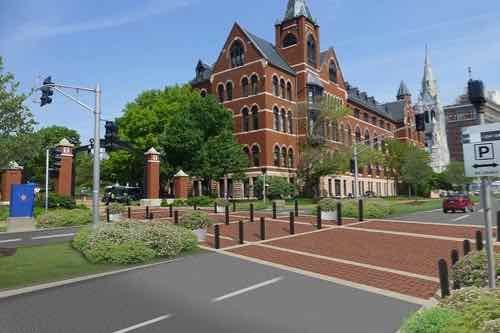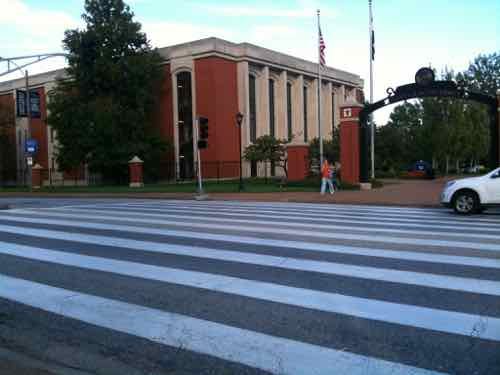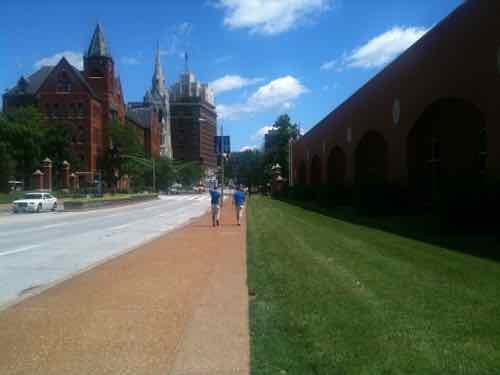Opinion: Proposed Crosswalk “Improvements:” On Grand Won’t Improve Pedestrian Safety
Grand Avenue runs through Saint Louis University’s main campus. It’s very busy because other North-South options like Spring & Theresa were vacated years ago. This means North-South that had 5 options now have 3: Vandeventer, Grand, and Compton. To handled the increased volume, on-street parking was removed. Without having to slow for cars parking, speeds increased. For pedestrians this is dangerous.
Since the city has given away public right-of-way (aka streets) to private property owners for years this problem exists throughout the city. The proposed solution is the same superficial one — decorative crosswalks. The warm & fuzzy element of urban planning.

Here again is what SLU is planning at Lindell, where West Pine used to be, and Laclede:
The project calls for the elimination of one of the three northbound lanes on Grand, which will allow the remaining lanes and the median to be widened. Bollards will also be installed to protect pedestrians who are about to cross the street as well as those who might be standing in the median. The roadway where the crosswalk is, will be changed to a brick-like surface to enhance the look and remind drivers to slow down. (KMOV)
Let’s take a closer look at each element.
- Removal of one Northbound travel lane: Reducing the number of travel lanes is good.
- Widen the remaining travel lanes & median: While widening the median is ok. increasing the width of travel lanes is the wrong thing to do! Wider lanes means driver’s feel safe at higher speeds. The remaining lanes should either be kept at their current width or reduced if you want to slow vehicles to increase pedestrian safety.
- Bollards installed: In this context bollards gov an impression of safety, though they might help since cars will be going even faster on wider lanes.
b
I’ve long been interested in the Grand & formerly West Pine crosswalk. I visited and observed at 4:45pm on Tuesday September 21, 2010 — nearly 8 years ago.

After I observed the crosswalk and took the photo (above) I decided to record what I was witnessing,
Here are the problems I listed at the end of the video:
- Signal timing is too long for pedestrians, they get tired of waiting and cross when they can. The timing needs to change so pedestrians can safely cross more frequently.
- The pedestrian button, like most in St. Louis, doesn’t do anything. Even the one person who pressed the button crossed before getting the “walk” signal. Eliminate the button or make the signal change quickly once pressed.
The fixes, save for shortening the crossing distance & giving students more space to stand between traffic, won’t make this crossing any safer. It’s possible the dark bricks will be less noticeable to motorists than the white paint. I know from a wheelchair perspective brick crosswalks are highly annoying. Motorists need to slow down before they reach the crosswalk.

One of the big problems is the lack of anything to get motorists to slow down: parked cars, narrow lanes, or — my favorite — street trees. It feels too wide open so motorists feel ok going faster than they should. Other things to do would be rumble strips in the pavement prior to reaching the crosswalk. make traffic stop more frequently during busy times, embed flashing LED lights in the lane markers ,a lighted sign overhead, etc.
Sadly too many are fooled by this region’s superficial efforts to appear to make pedestrian-friendly environments. Here’s the results of the recent non-scioentiofic Sunday Poll:
Q: Agree or disagree: Proposed changes to the crosswalk on Grand South of Lindell will greatly improve safety for pedestrians.
- Strongly agree 3 [13.64%]
- Agree 3 [13.64%]
- Somewhat agree 7 [31.82%]
- Neither agree or disagree 2 [9.09%]
- Somewhat disagree 2 [9.09%]
- Disagree 4 [18.18%]
- Strongly disagree 1 [4.55%]
- Unsure/No Answer 0 [0%]
This crosswalk will, to most eyes, look better. Aesthetics aside, it won’t perform any better — it might be worse. This is a way for SLU to mitigate damages from a future lawsuit by claiming they made an effort to improve safety. Actual safety is perceived as too inconvenient to motorists.
— Steve Patterson